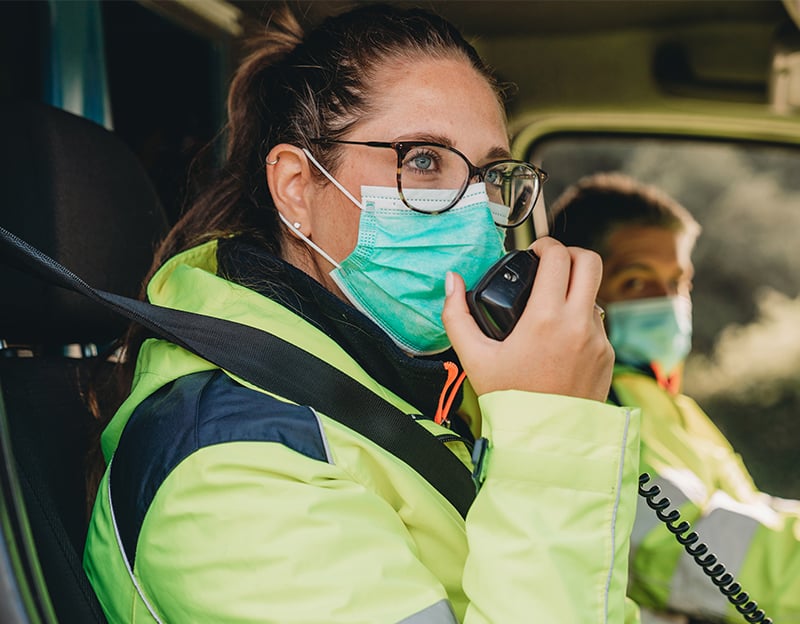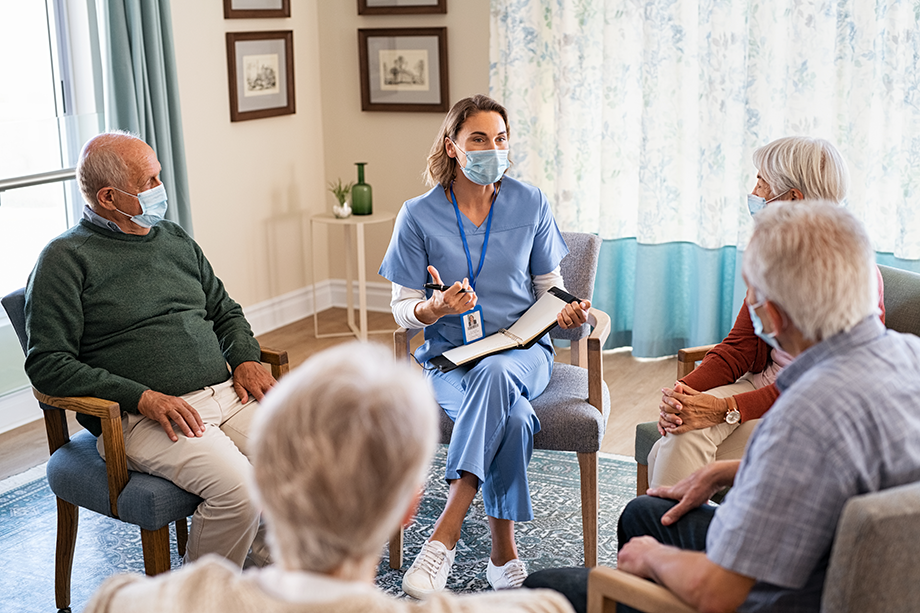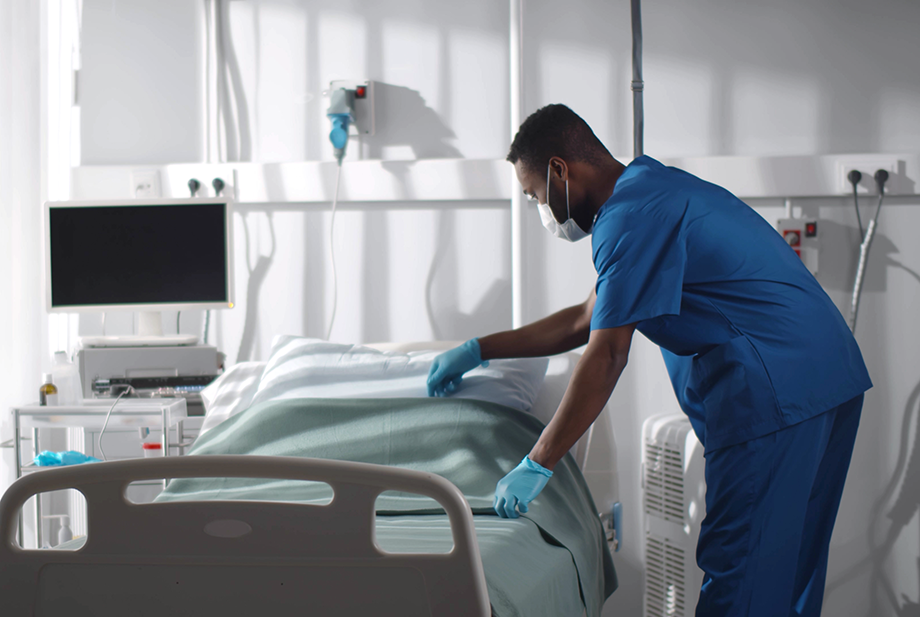EvaClean Resource Guide
Pathogenic Threats by Industry
Welcome to our Pathogen Resource Guide, where you’ll find comprehensive data on the viruses, bacteria, and fungi that cause the most illnesses in each industry. You’ll learn how pathogens spread and how you can proactively prevent infections before they occur.
Education
Schools and universities are susceptible to many bacterial and viral diseases, particularly during cold and flu season:
· Infectious outbreaks of influenza (flu), rhinovirus (common cold), and norovirus affect over 50 million students in 130,000 K-12 schools, as well as 19 million students in 5000 colleges and universities in the U.S.
· Norovirus among young children is responsible for approximately 2.2 million outpatient clinic visits and 465,000 ER visits per year. Students are also vulnerable to TB outbreaks.
· Between September and October 2022, respiratory syncytial virus (RSV) cases jumped from 1,245 to 7,993, five-times higher than the 2019-2020 season. Currently, there is no vaccine for RSV.

Athletics & Professional Sports
Infectious outbreaks are common in contact sports and easily spread in locker rooms and gyms:
- Respiratory viruses cause more illnesses among athletes than all other diseases combined.
- Athletes are vulnerable to blood borne pathogens like HIV, as well as community-acquired MRSA infections.

First Responders
Public safety professions are always on the front line where they encounter countless contagious pathogens:
- First Responders often work in scenarios where they are in contact with sick individuals and contaminants.
- Law enforcement officers, firefighters, and EMS personnel are regularly exposed to influenza, MRSA, VRSA, TB, C-Diff, HIV, andother diseases.

Food Service
Though food service providers work hard to maintain clean dining environments, the potential for contracting foodborne illnesses remains high:
- Foodborne illnesses account for approximately 900 deaths per year and around 100,000 hospitalizations. The most common include Salmonella, E. coli, Norovirus, and Hepatitis.
- Staph bacteria (Staphylococcus aureus/S. aureus) is one of the most prevalent causes of food poisoning.
- 75% of consumers will not visit a restaurant with negative reviews about its cleanliness.

Healthcare / Long-Term Care
Hospitals and senior care facilities by definition house virtually every type of bacteria, virus, and fungi, including some that aren’t found anywhere else, which puts patients at risk for acquiring healthcare-associated infections (HAIs):
- In American hospitals alone, the CDC estimates that HAIs account for an estimated 1.7 million infections and 99,000 associated deaths each year. Every day, approximately one in 31 U.S. hospital patients and one in 43 nursing home residents contract at least one HAI.
- During the first year of the pandemic, there was a 15% increase in hospital-onset infections, including carbapenem-resistant Acinetobacter, vancomycin-resistant Enterococcus, and drug-resistant Candida.
- The CDC’s 2021 HAI Progress Report revealed there was a 14% increase in MRSA bacteremia in acute-care and critical-access hospitals, inpatient rehabilitation facilities, and long-term care.

Over half of reported norovirus outbreaks in the U.S. occur in long-term care facilities.
· Over half of reported norovirus outbreaks in the U.S. occur in long-term care facilities.
· Studies showed 35% of floors and toys in children’s outpatient clinics and 20% of surfaces in neonatal intensive care units are contaminated with MRSA. The latter also had staphylococci on 60% of surfaces.
· The CDC estimates that Pseudomonas aeruginosa caused approximately 32,600 infections and 2,700 deaths among patients in U.S. hospitals. The bacterium accounts for over 10% of all HAIs.
· Klebsiella pneumoniae is one of the leading causes of HAIs and can cause significant morbidity, especially among immunocompromised patients. It is resistant to multiple antibiotics, making it difficult to treat.
· According to the CDC, nearly 500,000 Americans suffer from C. diff infections in a single year, of which 1 in 5 CDI patients will relapse.
· Candida auris (C. auris) cases increased 60% since the beginning of the pandemic. Between 2020 and 2022, clinical and screening cases in hospitals and long-term care facilities jumped from 755 and 1309 to 1994 and 5071 respectively. The C. auris mortality rate is upwards of 50%. At least 1 in 3 patients with invasive C. auris dies within a month of diagnosis.
· Many pathogens can form biofilms and continue to thrive on surfaces even after disinfection, including C. auris, MRSA, Carbapenem resistant Klebsiella pneumoniae, Pseudomonas aeruginosa, and S. aureus.

Offices / Commercial Facilities
Every public place where people work or gather indoors is an opportunity for contagious disease to spread:
- According to the CDC, since the start of this year’s flu season there have been 4.4 million infections, 38,000 hospitalizations, and 2,100 deaths.
- In 2023, Covid-19 cases began rising again at a rate of approximately 17% a week.
- It is estimated that up to half of all adults are colonized with S. aureus.
- Mold is one of the most dangerous hidden threats with unhealthy levels found in approximately 45 million buildings in America.

How Pathogens Spread
Illnesses are primarily spread through contact with infected individuals or through the surfaces and objects they touch:
· Contaminated surfaces (fomites) are vectors for transmission of virtually every contagious disease.
· Surfaces become reservoirs for pathogens when touched by hands contaminated with bacteria, stool, or other infectious materials.
· Respiratory viruses can spread when an infected individual sneezes or coughs and aerosol droplets land on surfaces, which are touched by others.
· Biofilms that form on surfaces allow dangerous pathogens to survive for months and continue spreading diseases even after disinfection.
One Solution For All Pathogens
Protecting people from so many different contagious diseases is exceedingly difficult. Most surface disinfectants only address some but not all pathogenic threats, leaving gaps and creating risks for infection. The key is NaDCC, one of the rare few chemistries proven to eradicate the most prevalent pathogens impacting industries and facilities of all types. EvaClean’s NaDCC disinfectants have broad-spectrum sporicidal, bactericidal, and fungicidal efficacy against the hardest-to-kill viruses, as well as biofilm and emerging viral pathogens.
To implement more effective cleaning protocols and keep your facility safe, use the handy tool below to cross-reference the pathogens that pose the greatest threat with the recommended disinfectant concentrations and dwell times necessary to eliminate them.
|
EPA List / Pathogens |
Contact Time / PPM |
|
List N - SARS-CoV-2 / Covid-19 |
1 minute / 2153 ppm |
|
List M - Influenza A Virus including H1N1 & Avian Influenza |
2-4 minutes / 1076 ppm |
|
List Q - Respiratory syncytial virus / RSV |
2 minutes / 1076 ppm |
|
List Q - Rhinovirus |
2 minutes / 1076 ppm |
|
List G, Q - Norovirus |
4 minutes / 1076 ppm |
|
List H - Staphylococcus aureus / S. aureus including Methicillin-resistant / MRSA & Staphylococcus epidermidis |
4 minutes / 1076 ppm |
|
List H - Vancomycin-resistant Enterococcus / VRE faecalis |
4 minutes / 1076 ppm |
|
List K - Clostridium difficile / C. diff |
4 minutes / 4306 ppm |
|
List B, E - Mycobacterium bovis / TB |
4 minutes / 5382 ppm |
|
List C, D, E - Human Immunodeficiency Virus / HIV |
2 minutes / 1076 ppm |
|
List D, E, F - Hepatitis A, B, C |
2-4 minutes / 1076 ppm |
|
Food-borne List - Salmonella enterica |
4 minutes / 1076 ppm |
|
Escherichia coli / E. coli |
4 minutes / 1076 ppm |
|
List P - Candida albicans & Candida auris / C. auris |
2 minutes / 4306 ppm |
|
List P - Aspergillus fumigatus |
1 minute / 4306 ppm |
|
List Q - Poliovirus |
4 minutes / 1076 ppm |
|
List Q - Emerging Viral Pathogens including Monkeypox |
1 minute / 2153 ppm |
|
Biofilm Bacteria |
4 minutes / 4306 ppm |
|
Streptococcus pneumoniae |
4 minutes / 4306 ppm |
|
Pseudomonas aeruginosa |
4 minutes / 1076 ppm |
|
Acinetobacter baumannii including multi-drug resistant |
4 minutes / 1076 ppm |
|
Carbapenem resistant Klebsiella pneumoniae |
2 minutes / 4306 ppm |